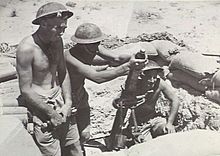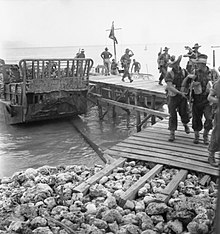24th Brigade (Australia)
| 24th Brigade | |
|---|---|
 24th Brigade personnel exercise at Palm Beach, August 1944 | |
| Active | 1940–46 |
| Country | Australia |
| Branch | Australian Army |
| Type | Infantry |
| Size | Brigade |
| Part of | 8th Division (1940) 9th Division (1940–46) |
| Engagements | World War II
|
| Commanders | |
| Notable commanders | |
1942–1946 |  |
The 24th Brigade was a
History
Formation
The brigade was formed on 1 July 1940 as part of the all volunteer Second Australian Imperial Force (2nd AIF). Consisting of three infantry battalions – the 2/25th, 2/28th and 2/43rd – the brigade was recruited from Queensland, Western Australia and South Australia. It opened its headquarters at Grovely, but moved to Enoggera a month later; its constituent units completed their training in their home locations, though. Upon establishment, the brigade was assigned to the 8th Division. The brigade's Queensland based battalion, the 2/25th, was detached in October 1940 and sent to garrison Darwin, Northern Territory;[1] the same month, the 24th Brigade was transferred to the newly formed 9th Division. This was part of a reorganisation of the 2nd AIF, which saw the less experienced units moved to the 9th Division, while those that were ready for combat were moved to the 7th Division.[2] The 2/25th Battalion was later transferred to the 25th Brigade, while it was replaced by the 2/32nd Battalion, which had been formed in the United Kingdom and would marry up with the brigade in the Middle East.[3] In December 1940, the 24th Brigade embarked for the Middle East, arriving in Palestine in February 1941, where the brigade concentrated, bringing together all three of its battalions for the first time.[4] The brigade's first commander was Brigadier Eric Plant.[5]
Middle East

The initial fighting in the
A period of rest and reorganisation followed before the 9th Division was sent to Syria in January 1942, relieving the 7th Division, which was to return to Australia due to the threat posed by Japan's entry into the war. In Syria, the 9th Division formed part of the Allied garrison that had been established there following the Syria–Lebanon campaign. Relieving the 21st Brigade, the 24th occupied positions in the interior, with its units spread out between Sir ed Danie, Haret Jedide, El Ayoun and Arle, although the 2/32nd moved from El Ayoun to Ramlieh in March. During May and June, the brigade rotated with the 26th Brigade to allow each formation to carry out collective training ahead of future operations, whilst still maintaining a defensive posture. By the end of June, the 9th Division received orders to return to Egypt, as the Germans began an offensive in North Africa that threatened the Allied base around Alexandria. The 24th Brigade established defensive positions around Lake Maryut in July, before being ordered to move forward to join the fighting in the First Battle of El Alamein. During this defensive battle, the brigade was temporarily detached to the British 1st Armoured Division and carried out raids from Ruweisat Ridge towards Alam Baoshaza. After returning to the 9th Division, the 24th Brigade carried out a series of attacks around the Qattara Track, Tel el Makh Khad and Ruin Ridge. During the assault on Ruin Ridge, the 2/28th Battalion suffered heavy losses when it became cut off, with the majority of the battalion eventually being taken prisoner. To make up for this loss, the 2/3rd Pioneer Battalion was temporarily assigned to the brigade, whilst the 2/28th was rebuilt in Palestine.[13] Meanwhile, the rest of the brigade fought to hold the German offensive and in September launched a series of raids in preparation for a coming offensive.[12]

In late October, the Allies went on the offensive, launching the Second Battle of El Alamein. The 9th Division was assigned a role in the initial break-in effort, attacking around Tel el Eisa. As a part of this effort, the 24th Brigade launched a diversionary assault around the coast against the 15th Panzer Division.[14] As initial efforts to achieve a break in were only partially successful, the 20th and 26th Brigades, having achieved some success in their areas, struck north in a renewed effort. Later, the 24th Brigade took over from the 26th which was heavily depleted from its efforts; together with the 2/3rd Pioneers they repelled a German counter-attack, securing the Allied break-in, which was achieved in early November through the positions captured by the 20th Brigade.[15] During the fighting in early November, the brigade's commander, Godfrey was mortally wounded by an artillery barrage,[16] and was replaced by Brigadier Bernard Evans, previously of the 2/23rd Battalion.[17][18] In the wake of the break-in effort, other Allied units exploited their success, and after carrying out mopping up operations, the 24th Brigade was withdrawn back to Palestine, in preparation for the 9th Division's return to Australia for future operations in the Pacific against the Japanese.[15]
New Guinea
A period of leave followed, after which the brigade's personnel concentrated around

After the capture of Lae, the Allies decided to follow up their success with another amphibious operation to secure
Borneo
A couple of months of leave followed for the brigade's personnel, after which it concentrated at

Staging out of
Elsewhere, the 2/32nd Battalion subsequently landed on Labuan on 12 June, but was transferred to the mainland several days later, where it captured the town of Weston before moving on towards Beaufort.[29] It was assessed that Beaufort was occupied by up to 1,000 Japanese defenders, and as a result, following the fighting on Labuan, the remainder of the 24th Brigade was landed on the mainland. The 2/43rd landed around Mempakul to secure the Klias Peninsula with the 2/11th Commando Squadron, before moving by barge along the Klias River. They then marched overland to the Padas River, linking up with the 2/32nd at Kandu to join the attack on Beaufort on 27/28 June,[30] during which over 100 Japanese were killed.[31] Meanwhile, the 2/28th went ashore around Weston and carried the advance towards Papar,[32] which was reached in July. The war came to an end in mid-August, by which time the brigade was tasked with securing Japanese prisoners in northern Borneo and helping to re-establish British civil administration through the British Borneo Civil Affairs Unit.[33][34]
Disbandment
Following the conclusion of hostilities, the brigade was used to oversee the surrender of Japanese troops in the local area, and maintaining law and order until civilian authorities could be re-established. During this time, the brigade's battalions were spread out between
Attached units
The following units were assigned to the brigade during the war:[39][40]
- 2/25th Battalion to 25th Brigade[41]
- 2/28th Battalion
- 2/43rd Battalion
- 2/32nd Battalion from 25th Brigade
Commanding officers
The following officers commanded the 24th Brigade during the war:[42][40]
- Brigadier Eric Plant (1940–1941)
- Brigadier Arthur Godfrey (1941–1942)
- Brigadier Bernard Evans(1942–1943)
- Brigadier Selwyn Porter (1943–1945)
References
Citations
- ^ Draydon 2001, p. 23.
- ^ Johnston 2002, pp. 2–3.
- ^ a b "2/32nd Battalion". Second World War, 1939–1945 units. Australian War Memorial. Archived from the original on 7 April 2012. Retrieved 17 July 2012.
- ^ McKenzie-Smith 2018, p. 2101.
- ^ Sutton, R. (2002). "Plant, Eric Clive Pegus (1890–1950)". Australian Dictionary of Biography, Volume 16. Melbourne University Press. Retrieved 29 July 2018.
- ^ McKenzie-Smith 2018, pp. 2101–2102.
- ^ Wilmot 1993, p. 198.
- ^ Wilmot 1993, pp. 65–83.
- ^ Wilmot 1993, pp. 198–203.
- ^ Wilmot 1993, pp. 220 & 235.
- ^ Wilmot 1993, p. 284.
- ^ a b McKenzie-Smith 2018, p. 2102.
- ^ "2/28th Battalion". Second World War, 1939–1945 units. Australian War Memorial. Archived from the original on 3 April 2012. Retrieved 3 July 2012.
- ^ Latimer 2002, p. 177.
- ^ a b McKenzie-Smith 2018, pp. 2012–2013.
- ^ Wood, James (1996). "Godfrey, Arthur Harry Langham (1896–1942)". Australian Dictionary of Biography, Volume 14. Melbourne University Press. Retrieved 29 July 2018.
- ^ Dunstan, David (2007). "Evans, Sir Bernard (1905–1981)". Australian Dictionary of Biography, Volume 17. Melbourne University Press. Retrieved 29 July 2018.
- ^ "Brigadier Sir Bernard Evans D.S.O., E.D., C.A.V." Monuments Australia. Retrieved 27 July 2018.
- ^ a b c McKenzie-Smith 2018, p. 2103.
- ^ Keogh 1965, p. 299.
- ^ Keogh 1965, pp. 310–311.
- ^ Dexter 1961, pp. 444–445.
- ^ a b c d McKenzie-Smith 2018, p. 2013.
- ^ Coulthard-Clark 1998, pp. 244–245.
- OCLC 70677943. Retrieved 29 July 2018.
- ^ Keogh 1965, p. 332.
- ^ Johnston 2005, p. 14.
- ^ Long 1963, pp. 474–475.
- ^ Long 1963, pp. 472 & 475.
- ^ Long 1963, p. 479.
- ^ Coulthard-Clark 1998, p. 253.
- ^ Long 1963, Map p. 476.
- ^ McKenzie-Smith 2018, p. 2014.
- ^ Long 1963, pp. 495–496.
- ^ a b c "AWM52 8/2/24/40: 24th Infantry Brigade: October 1945 – January 1946". Unit war diaries, 1939–1945. Australian War Memorial. Retrieved 29 July 2018.
- ^ Combe, Ligertwood & Gilchrist 1992, pp. 239–242.
- ^ James 2009, pp. 15–16.
- ^ Long 1963, pp. 500–501.
- ^ "24 Australian Infantry Brigade: Unit Subordinates". Orders of Battle. Archived from the original on 6 July 2007. Retrieved 7 January 2010.
- ^ a b Johnston 2002, p. xv.
- ^ Draydon 2001, pp. 43–47.
- ^ "24 Australian Infantry Brigade: Command Appointments". Orders of Battle. Archived from the original on 4 March 2016. Retrieved 7 January 2010.
Bibliography
- Combe, Gordon; Ligertwood, Frank; Gilchrist, Tom (1992) [1972]. The Second 43rd Australian Infantry Battalion 1940–1946. Swanbourne, Western Australia: John Burridge Military Antiques. ISBN 978-0-9599506-0-1.
- Coulthard-Clark, Chris (1998). Where Australians Fought: The Encyclopaedia of Australia's Battles (1st ed.). St Leonards, New South Wales: Allen & Unwin. ISBN 1-86448-611-2.
- Dexter, David (1961). The New Guinea Offensives. Australia in the War of 1939–1945, Series 1—Army. Volume VI (1st ed.). Canberra, Australian Capital Territory: Australian War Memorial. OCLC 2028994.
- Draydon, Allan (2001) [2000]. Men of Courage: A History of 2/25 Australian Infantry Battalion 1940–1945. Loftus, New South Wales: Australian Military History Publications. ISBN 0-646-38663-8.
- James, Karl (2009). "Soldiers to citizens". Wartime (45). Canberra: Australian War Memorial: 14–17. ISSN 1328-2727.
- ISBN 1-86508-654-1.
- Johnston, Mark (2005). The Huon Peninsula 1943–1944. Australians in the Pacific War. Canberra: Department of Veterans' Affairs. ISBN 1-920720-55-3.
- OCLC 7185705.
- ISBN 978-0-7195-6203-7.
- Long, Gavin (1963). The Final Campaigns. Australia in the War of 1939–1945. Series 1 – Army. Vol. VII. Canberra, Australian Capital Territory: Australian War Memorial. OCLC 1297619.
- ISBN 978-1-925675-146.
- ISBN 0-14-017584-9.
External links
- 24th Brigade, Orders of Battle.com
- 24th Brigade war diary, Australian War Memorial

